70 Oz How Many Liters
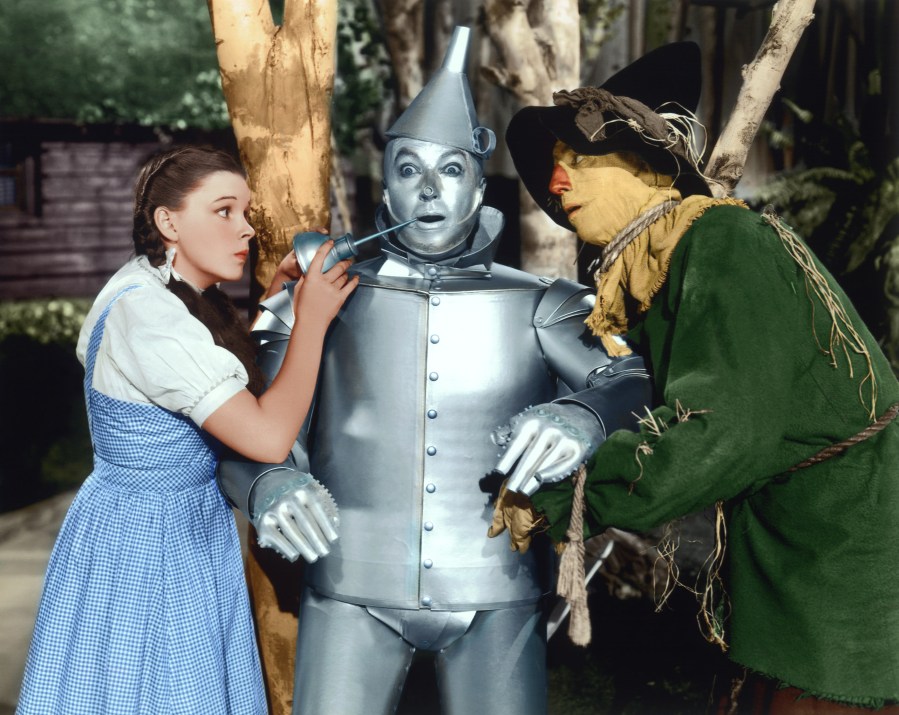
From offscreen friendships and jarring pay inequality to the special effects and makeup tricks that brought some of the globe's favorite film characters to life, The Wizard of Oz (1939) had so much going on backside the emerald curtain and the Technicolor gloss of an amazing fantasy earth.
In accolade of the 80th ceremony of the pic, follow the yellowish brick slideshow to peek backside that drapery and acquire more about the secrets and fun facts that make the beloved motion picture a timeless classic.
Margaret Hamilton Was a Fan Before the Film
As a self-proclaimed lifelong fan of 50. Frank Baum's Oz series, Margaret Hamilton was thrilled to be considered for a office in the 1939 film adaptation. Hamilton called her agent to inquire which character the producers wanted her to play, and her agent famously said, "The witch — who else?"
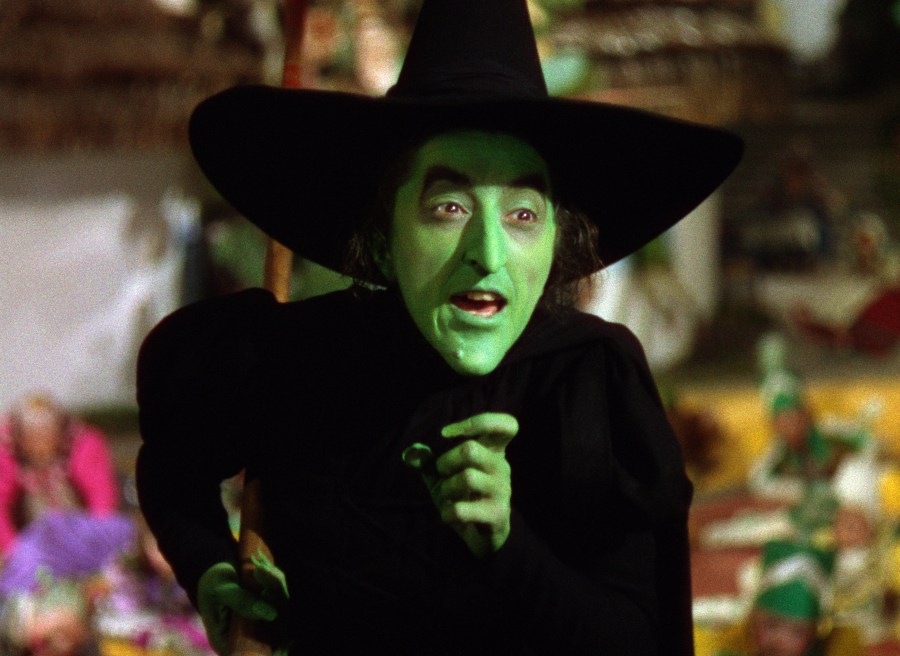
Hamilton, a single female parent, fought MGM for an agreed upon corporeality of guaranteed work fourth dimension. Iii days earlier filming began, the studio agreed to a five-week bargain. In the end, Hamilton was on set for three months, just many of her scenes were cut for being too scary for audiences.
Certain, Dorothy Gale doesn't need prosthetics or aluminum makeup, but that doesn't mean Judy Garland wasn't put through the costume department wringer. Although she was immature at the time, the 16-yr-sometime Garland had to habiliment a corset-like device so she looked more like a preadolescent child.
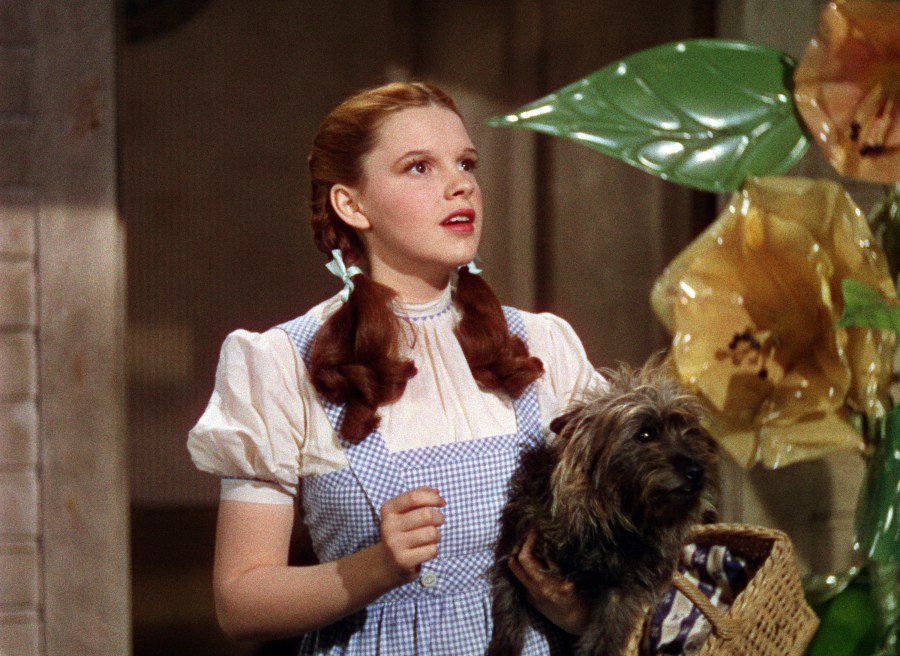
Director Richard Thorpe suggested Garland wearable a blonde wig and loads of "baby-doll" makeup (every bit whatever preadolescent girl would…?). Luckily, that vision of the graphic symbol inverse. After MGM fired Thorpe, the intermediate manager George Cukor nixed the heavy makeup and wig. Instead, he told Garland to be herself. Smart move.
The "Skywriting" Scene Employed Some Great Movie Magic
The Wizard of Oz employs a lot of great picture tricks, and some of the well-nigh unique were used in the skywriting scene. In it, the Wicked Witch (Margaret Hamilton) flies to a higher place the Emerald Urban center, leaving the phrase "Surrender Dorothy" in her wake in black smoke.
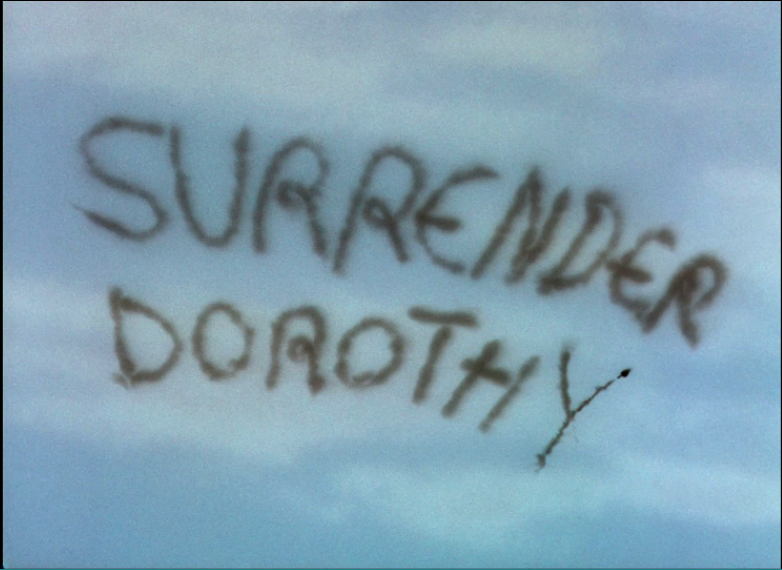
Using a hypodermic needle, the special effects team spread black ink across the bottom of a glass tank that was filled with a thick, tinted liquid (some speculate milk). They wrote the phrase in reverse and filmed the scene from below. Initially, the skywriting concluded with the ominous "Or Die — West W W."
The "Snowfall" in the Poppy Field Was Really Dangerous
One of the Wicked Witch's last-ditch efforts to impede Dorothy's quest to encounter the Wonderful Magician of Oz involves a poppy field and some magical sleep-inducing snowfall. While many like to joke that the poppies and their drowsiness are the result of opium (a component of poppies), the scene has a much more breathy toxic connectedness than that.
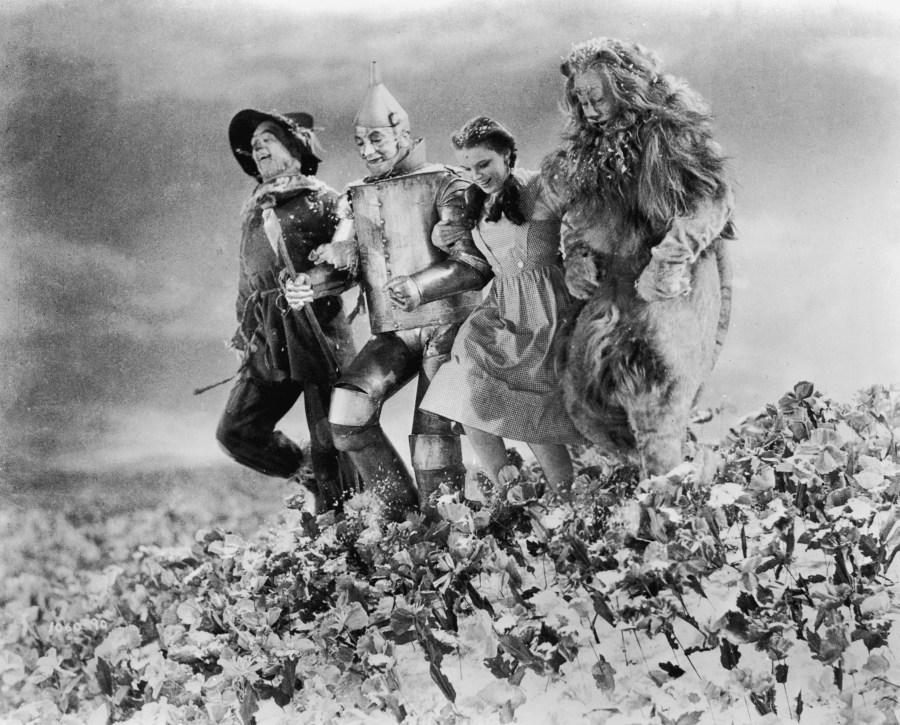
All that magical snow? Information technology'southward actually 100% industrial-class chrysotile asbestos. Even though the health risks associated with the textile were known at the time, it was still Hollywood's preferred choice for false snow. Our advice to Dorothy? Don't catch whatsoever snowflakes on your tongue.
Scarecrow's Makeup Stuck Around for Awhile
In the finish, Ray Bolger (Scarecrow) was probably grateful for Buddy Ebsen (the original Tin Homo's) willingness to merchandise parts with him for more reasons than one. The Tin Man'southward aluminum makeup caused a huge amount of bug for Ebsen, who was replaced by Jack Haley.
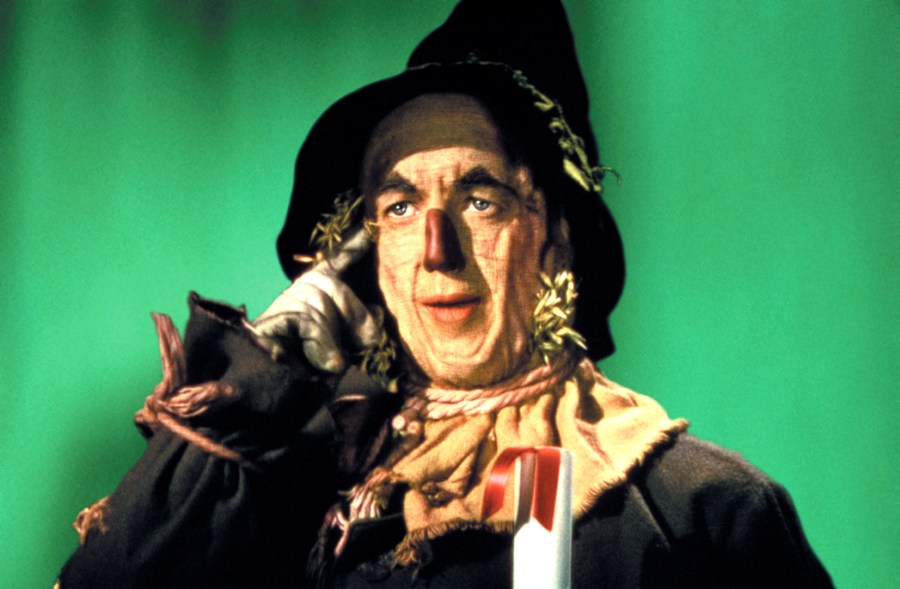
Although Bolger's makeup experience was better than Ebsen'south, he even so had some issues. The Scarecrow's makeup consisted of a rubber prosthetic, complete with a woven pattern that mimicked the look of burlap. Later the pic wrapped, the prosthetic left patterns on Bolger'south face that took more than a year to fade.
Margaret Hamilton Was Burned On Gear up
In a flare-up of flames and red smoke, the Wicked Witch (Margaret Hamilton) vanishes from Munchkinland. Although the scene is terrifying for viewers, information technology may have instilled more fearfulness for Hamilton. On the offset take, the smoke rose from a subconscious trapdoor too early on.
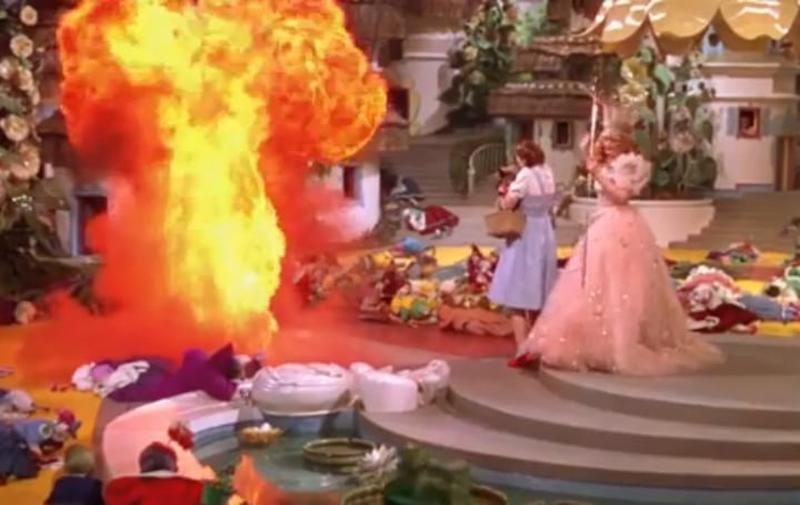
For the second accept, Hamilton stood on the trapdoor as planned, but her cape snagged on the platform when the burn flared up. Her copper-containing makeup heated upwards instantly, causing second- and third-degree burns on her easily and face. To make matters worse, the coiffure tried to remedy her burns with (an even more painful) acetone solvent.
The Flying Monkeys Became Falling Monkeys
The Wicked Witch's legion of flying monkeys — or Winged Monkeys as they're called in the source material — take certainly been a source of terror for generations. Most as scary as the Witch herself, these henchmen soar onto the scene to kidnap Dorothy and Toto — thanks to the magic of piano wires.
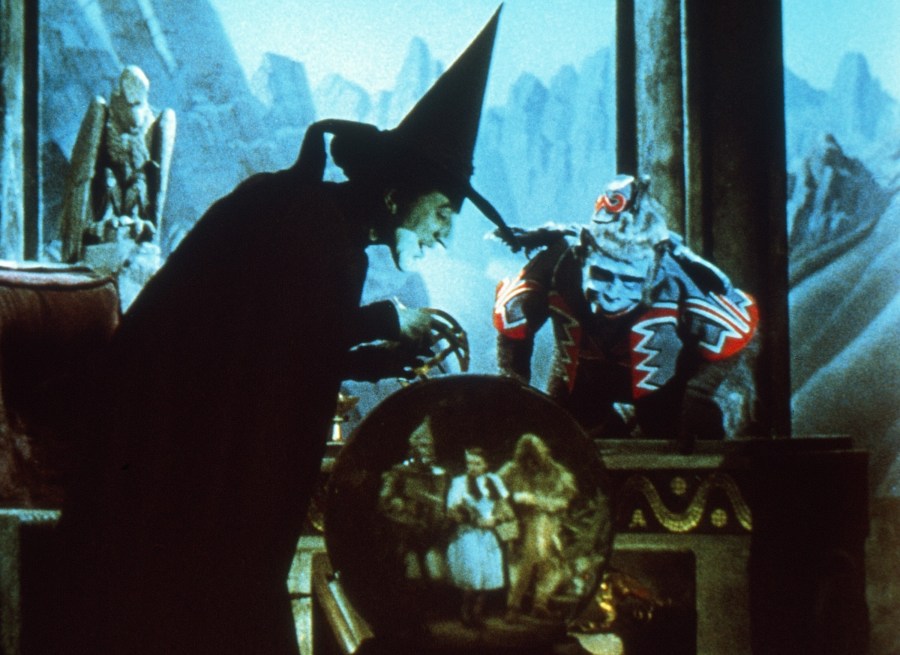
However, the aerial stunt went awry when several of the piano wires snapped, sending actors plummeting a few anxiety to the soundstage flooring. To create such a vast troupe of monkeys (and cut down on human being marionettes), filmmakers made miniature condom monkeys to help populate the sky.
"Over the Rainbow" Was Virtually on the Cutting Room Floor
To no one'south surprise, the American Film Institute ranked "Over the Rainbow" #one on a list of 100 Greatest Songs in American Films. Just what may surprise yous? The (arguably) most iconic song of Judy Garland'southward career was almost cut from the flick.
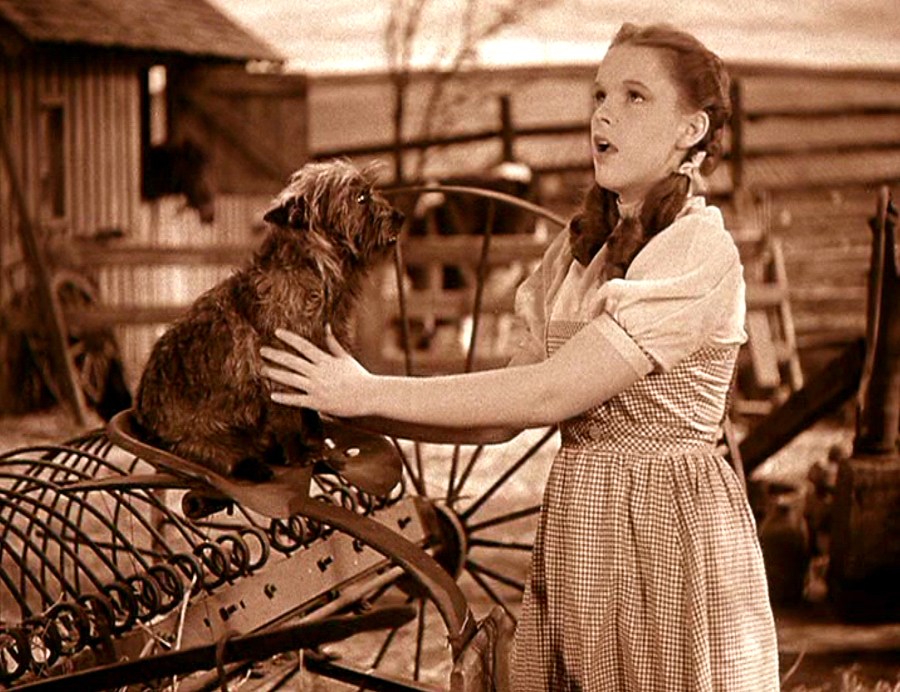
Studio execs at MGM thought the vocal made the Kansas scenes too long. Moreover, filmmakers were concerned that children wouldn't understand the vocal's pregnant. Luckily, this unfounded concern melted like lemon drops. Unfortunately, Garland's bawling reprise of the song was left on the cutting room floor.
The Tin can Man Costume Didn't Allow Jack Haley to Rest Easy
Although Bert Lahr had to schlep around in a ninety-pound lion costume, Jack Haley didn't have information technology easy either. From the lingering concerns about the aluminum paste-based makeup on his face and hands to the minimal flexibility of the "tin" body and arms, Haley faced some challenges.
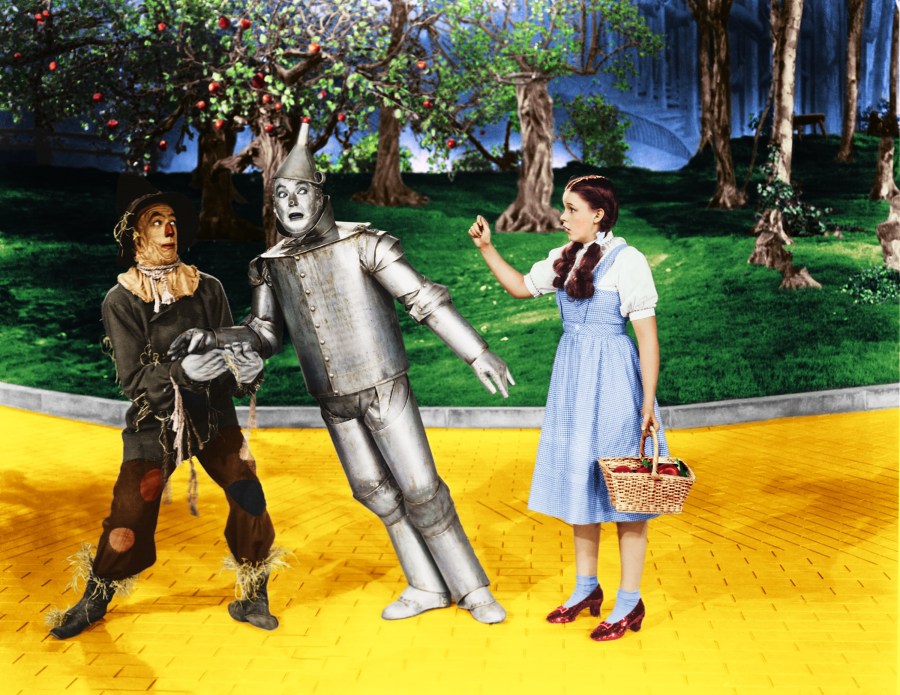
Reportedly, his costume was then stiff that he had to lean confronting a lath to residuum properly. Many years later, player Anthony Daniels, known for playing the protocol droid C-3PO in the Star Wars films, had the same issue with his rigid costume. It seems even fantasy and sci-fi can't help folks escape all their issues.
The Original Tin Homo Was Rushed to the Hospital
Initially, Buddy Ebsen was cast every bit the Scarecrow, simply traded parts with Ray Bolger. All the same, Ebsen's new character, the Tin Man, caused him a slew of issues. Namely, the character'south silverish makeup contained a harmful aluminum dust that coated Ebsen's lungs.
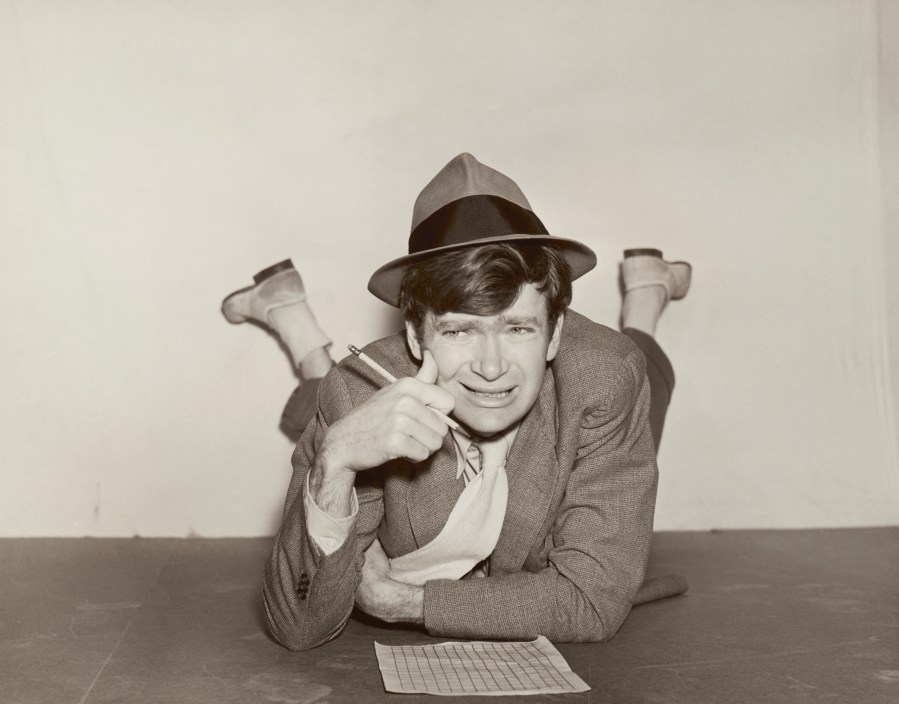
To make matters worse, Ebsen had an allergic reaction, and, unable to exhale, he was rushed to the hospital. MGM recast the part with Jack Haley (and changed upward the makeup), but didn't explain why Ebsen "dropped out." Although Ebsen didn't appear in the final motion picture, his vocals tin can be heard in "Nosotros're Off to See the Wizard."
A Stocking & Some Miniatures Gave Us the Tornado
The tornado that strikes the Gale homestead is full of applied special effects that actually hold upward. The funnel itself was really a 35-foot long stocking fabricated of muslin. The special effects team spun it around miniatures that resembled the farms and fields of Kansas. Against the painted backdrop, the tornado looks menacing.
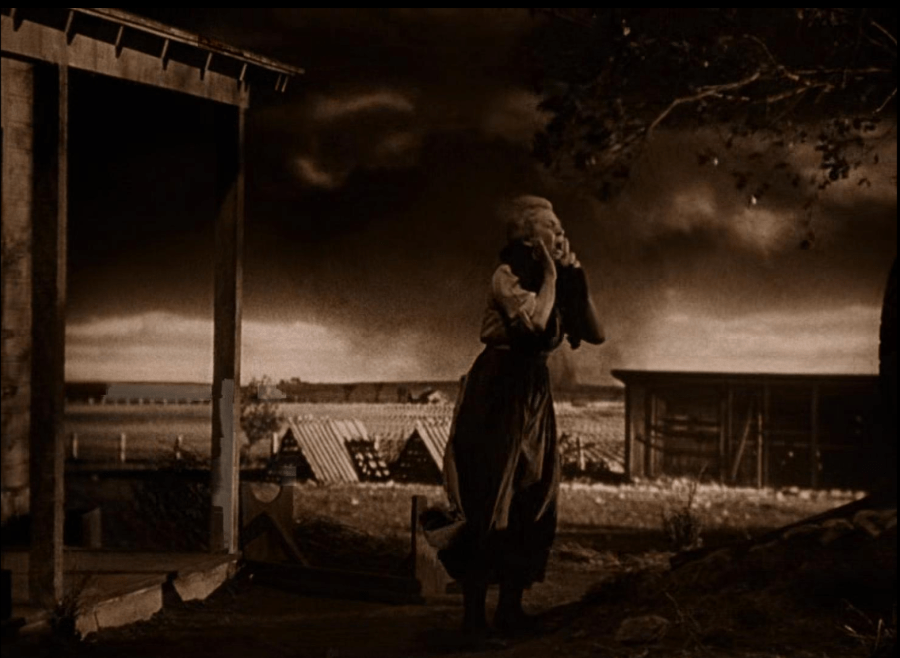
The Gale house, which falls from the heaven and into Oz, is merely a miniature house that was dropped onto a heaven painting. Filmmakers then reversed the footage to brand it look like the house was falling out of the clouds.
Hollywood Didn't Pay Up So Either
Pay inequality has ever been an event in Hollywood. For example, Adriana Caselotti, vocalisation of the titular character in Walt Disney's Snow White and the Seven Dwarfs (1937), made $970 for her functioning, though the pic went on to brand roughly $viii one thousand thousand.
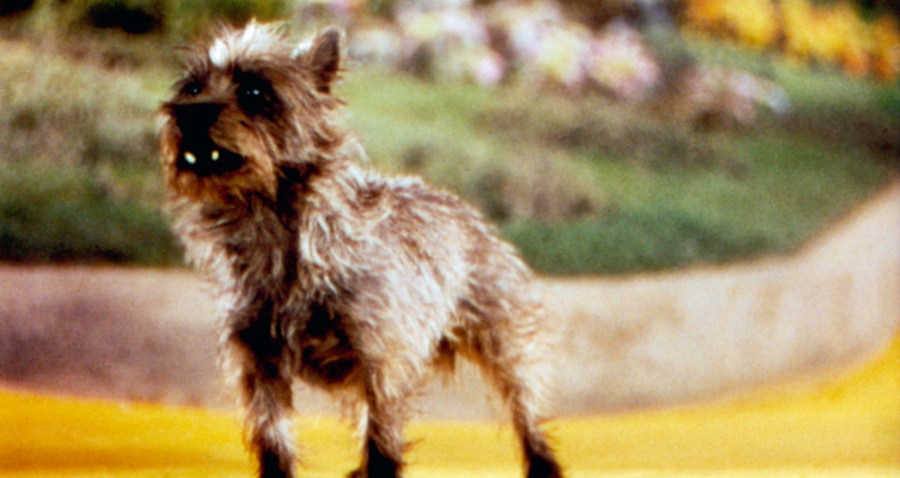
According to the Los Angeles Times, Judy Garland'south pay was improve than Caselotti's — playing Dorothy earned her $500 a calendar week — only information technology still didn't reflect the film's success. Even more discouraging, the folks who portrayed the citizens of Munchkinland were paid a mere $50 per week. (Meanwhile, Terry the canis familiaris earned $125 per week equally Toto. A real yikes.)
Bert Lahr's Lion Costume Was Taxing
Originally, MGM thought it might cast its mascot — the actual lion used in the studio's title carte — as the cowardly character. Fortunately, for the safe of the actors and the brute, the filmmakers decided to cast player Bert Lahr as the anthropomorphic character instead.
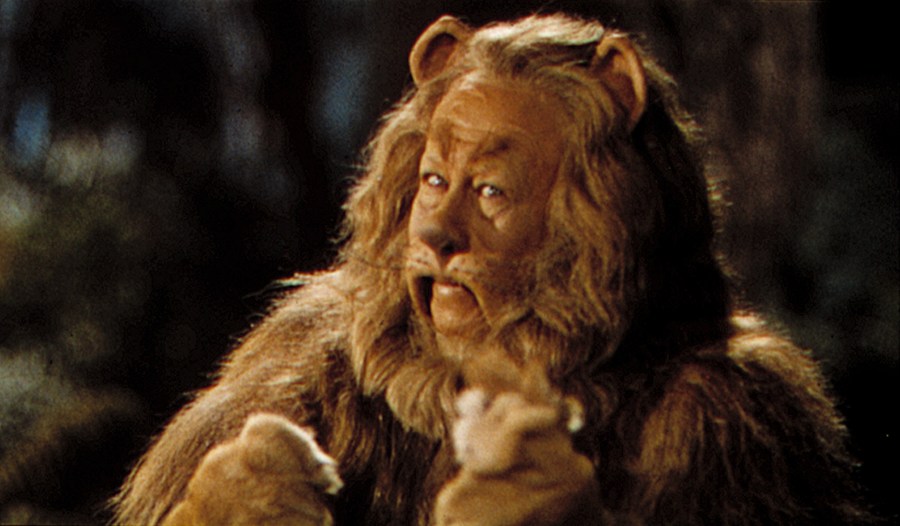
To brand a convincing creature, the costume department fashioned Lahr a 90-pound outfit made from real lion skin. Nonetheless, the arc lights used on prepare made things a steamy 100 degrees during filming, which meant Lahr did a lot of sweating unrelated to his character's nerves. Each nighttime, two stagehands dried the costume for the next twenty-four hours.
The Initial Box Office Returns Were Uneven
The film started shooting in Oct of 1938 simply didn't wrap until March of 1939, racking up an unheard of $2,777,000 in costs. That's nearly $50 million adjusted for inflation. Upon its initial release, the movie simply earned $three million at the box office — most $51.8 one thousand thousand by today'due south standards.
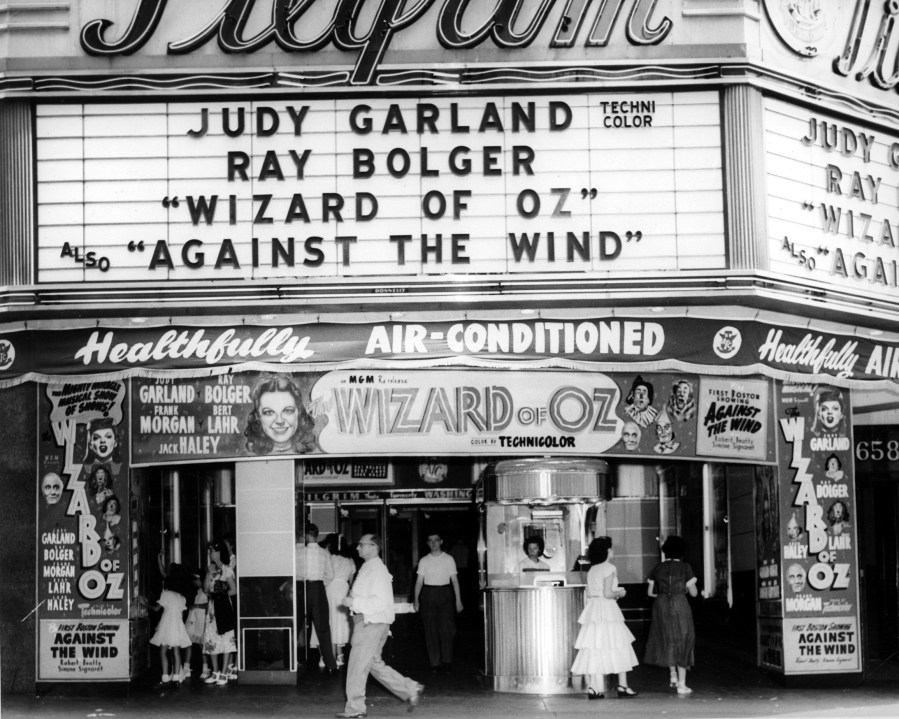
Although that seems impressive for a Depression-era moving-picture show, retrieve that Disney made $8 million with Snow White and the Seven Dwarfs (1937). The Wizard of Oz's pocket-sized success in the U.S. barely covered product and film rights' costs — MGM paid $75,000 to the publisher for those — but success overseas fortunately bolstered the film'due south returns.
The Nighttime Side of Oz in a Time Earlier "Me As well"
Judy Garland was just 16 years erstwhile when she was cast equally Dorothy. Insecure and lonesome, she became fond to amphetamines and barbiturates, which were often given to young actors to assist them sleep after studios shot them up with adrenaline so they could piece of work long hours.
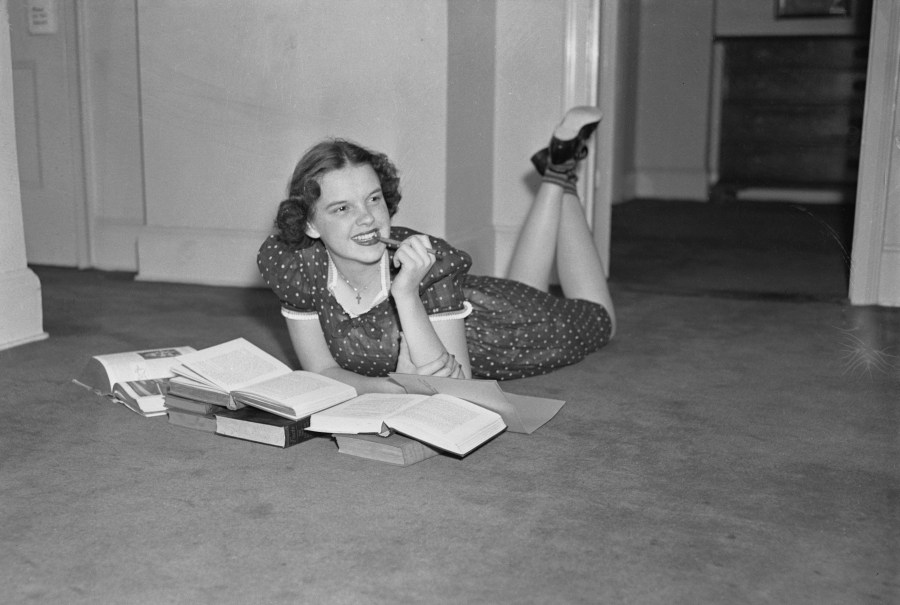
The spotlight — and her damaging contract with MGM — didn't assistance, leading to lifelong struggles with an eating disorder and alcoholism. According to a author for Limited, "[Garland] was molested by older men, including studio chiefs [and head Louis B. Mayer], who considered her little more than their 'property.'" Moreover, MGM forced Garland to stick to a wildly unhealthy nutrition of cigarettes, coffee and chicken soup.
The Vocalism of Snowfall White Had a Cameo
A few years before The Magician of Oz debuted, Walt Disney's characteristic-length blithe film Snow White and the Seven Dwarfs (1937) became a blast-hit. Not only did the film revolutionize the animation industry, it likewise reinvigorated the fantasy genre.
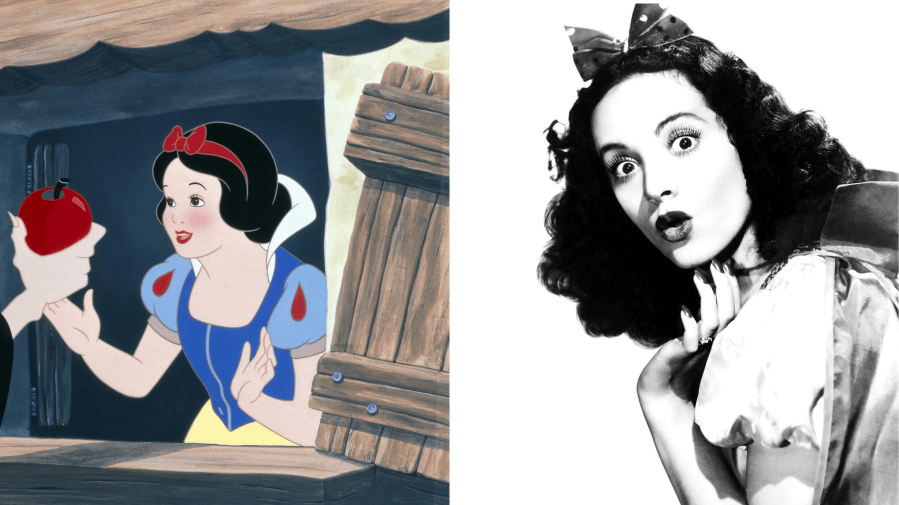
Disney wanted to follow upward Snow White — and so the virtually successful flick of all time — with an adaptation of The Wizard of Oz, but MGM endemic the rights. By happenstance, Adriana Caselotti, who voiced Snow White, had an uncredited part in Oz. During the Tin Man'south "If I Simply Had a Centre," Caselotti speaks her sole line, "Wherefore art thousand Romeo?"
The Reddish Slippers Are Props & Treasured Artifacts
Keeping in line with the volume, Dorothy's iconic footwear was originally silver, but screenwriter Noel Langley felt the red color would really popular in glorious Technicolor. Designed by MGM'due south principal costume designer Gilbert Adrian, the shoes are each covered in about two,300 sequins.
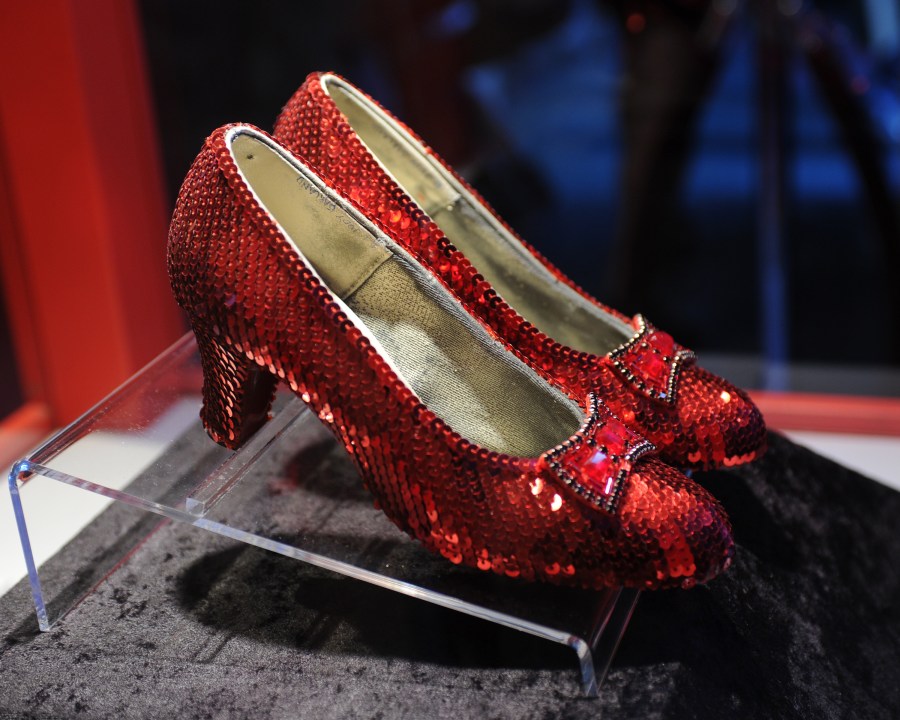
One of the remaining pairs is on view in the Smithsonian Institution'southward National Museum of American History. Since the brandish is then heavily trafficked, the museum has replaced the carpet there several times. Another pair were stolen from Minnesota's Judy Garland Museum in 2005, but the FBI recovered the slippers for the institution in 2018.
Only One Sequence Was Filmed "On Location"
The Wizard of Oz is your archetype adventure story, and Dorothy's quest leads her from a Kansas subcontract to another world — complete with corn fields, poppy-filled meadows and forests. However, despite all these scenic locations, nearly all the scenes were shot on a soundstage.
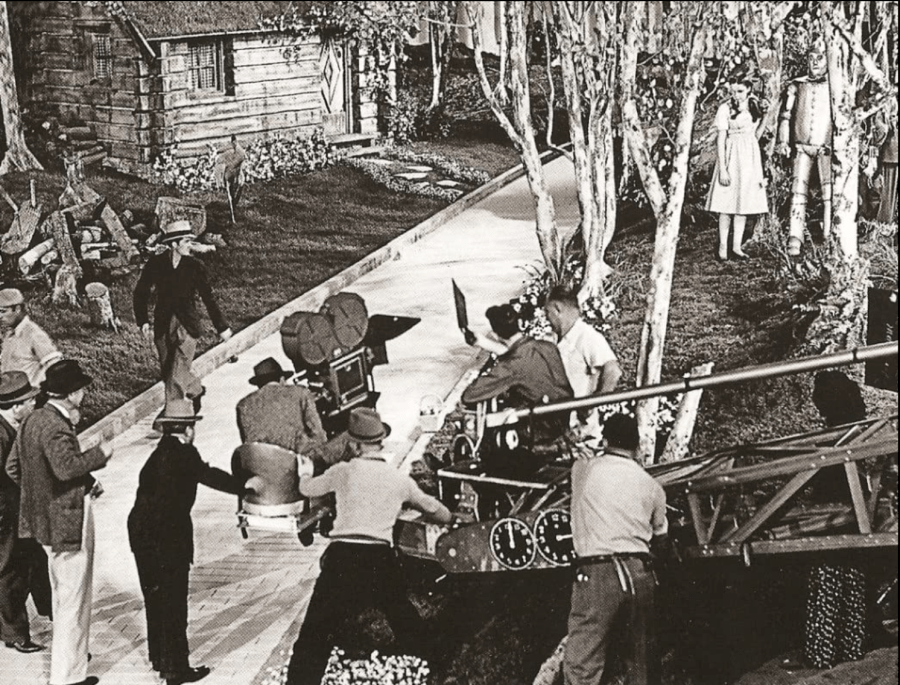
As was customary at the time, immense, detailed backdrops were painted by studio artists, making it possible for filmmakers to transport audiences to far away places without filming on location. In fact, the just location footage in the motion picture is the opening championship sequence — those clouds are 100% the real bargain.
A 2d Toto Was Brought In
Toto, played primarily by Terry, is one of the about dear dogs in pic history. Terry was famously not a huge fan of special effects and can often be seen running out of a shot when something loud or alarming happens — similar when the Tin Homo spouts out all of that steam.
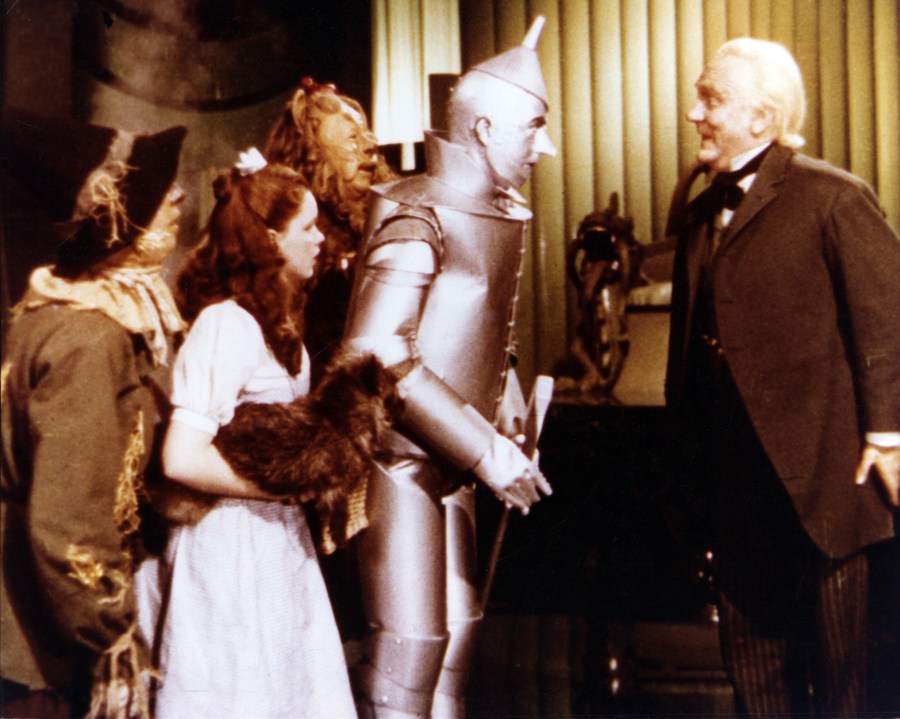
After one of the Witch's guards accidentally stepped on her, Terry was on bedrest for two weeks. Filmmakers went through two doubles to discover ane that resembled the original canine actor more closely.
Fun fact: Judy Garland was and so fond of Terry that she wanted to prefer the dog.
Margaret Hamilton "Mourns the Wicked" Witch
In add-on to being a huge fan of the Oz books, Margaret Hamilton also believed her graphic symbol was more just your run-of-the-mill evil villain. More than 35 years later on the moving-picture show debuted, Hamilton, donning her Witch'south costume to show kids information technology was make-believe, appeared on Mister Rogers' Neighborhood, where Fred Rogers interviewed her most the character.
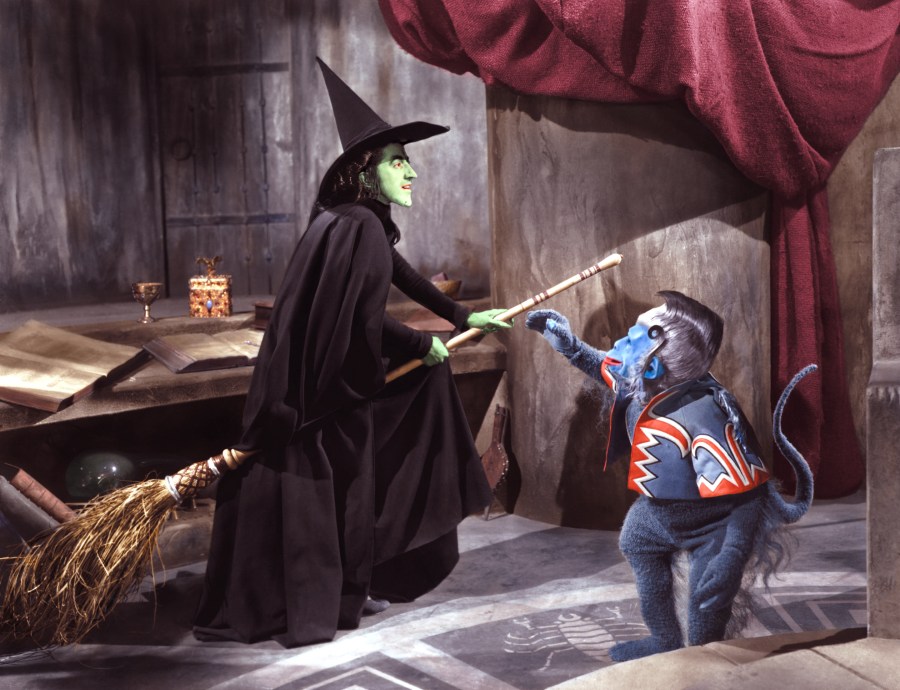
According to Hamilton, the so-chosen Wicked Witch relished everything she did, but she was too a deplorable, lonely figure. In short, things never went well for the frustrated Witch. Oddly enough, the Broadway musical Wicked also takes this approach to the Witch's character.
The "Equus caballus of a Different Colour" Was Fabricated Possible Thanks to a Nutrient Product
In 1939, audiences were just every bit amazed as Dorothy, Scarecrow, Tin Man and the Cowardly Lion when the horse in Emerald Urban center took on a rainbow of colors. This "horse of a different colour" was made possible thank you to a surprising food item…
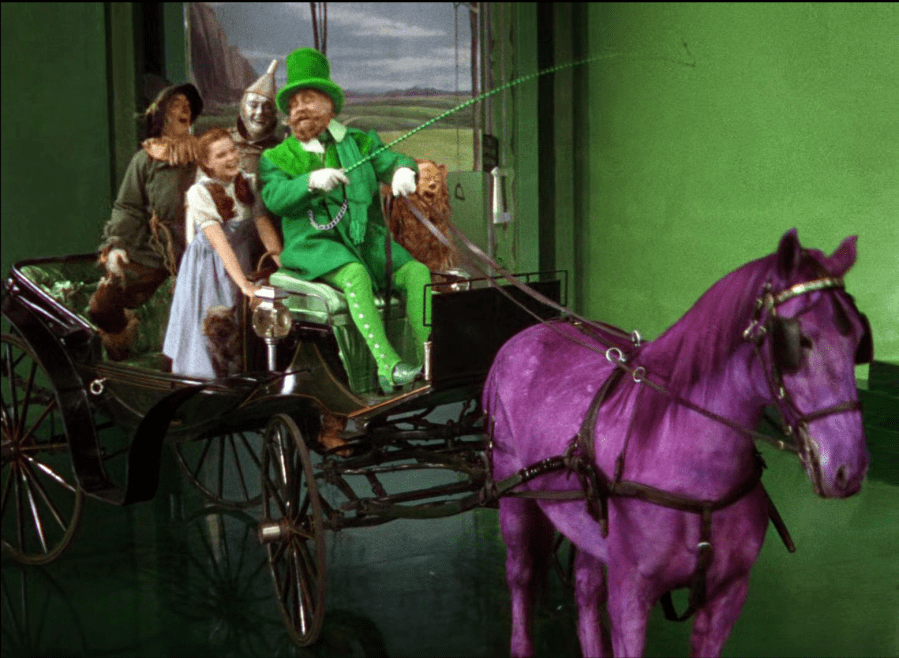
Clot-O crystals were used to color the horses, which meant filmmakers had to move rapidly — the animals were eager to lick upwardly the sweet care for. But the colorful steed isn't the only interesting component in this fan-favorite scene. The horse-drawn carriage was once endemic past President Abraham Lincoln and now resides at the Judy Garland Museum.
The Makeup Department Hired Extra Hands
From the citizens of Munchkinland and Emerald City to the Witch'south flying monkeys, so many actors had to undergo a makeup transformation in order to give life to this fantasy film. To continue upwards with the daily demands, MGM called upon workers from the studio mailroom and courier service to manage makeup stations.
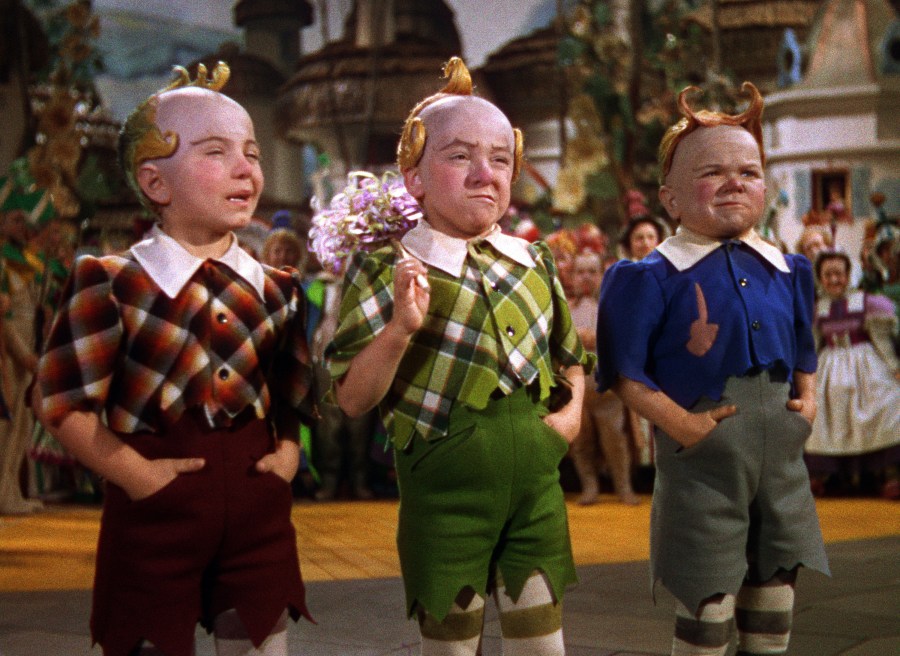
Since virtually of the Ozian ensemble required prosthetics, makeup artists — and "makeshift" artists — formed a kind of costuming assembly line. Most actors had to arrive before v:00 in the morning — six days a week! — to begin the intensive process.
Memorable (& Often Misquoted) Lines Fill the Motion picture
The film is chock-full of iconic, memorable songs, and it has the bang-up fortune of being responsible for some of the most quoted lines in picture show history besides. In 2007, Premiere compiled a list of "The 100 Greatest Moving picture Lines" and placed a whopping three of the movie'south lines on the listing.
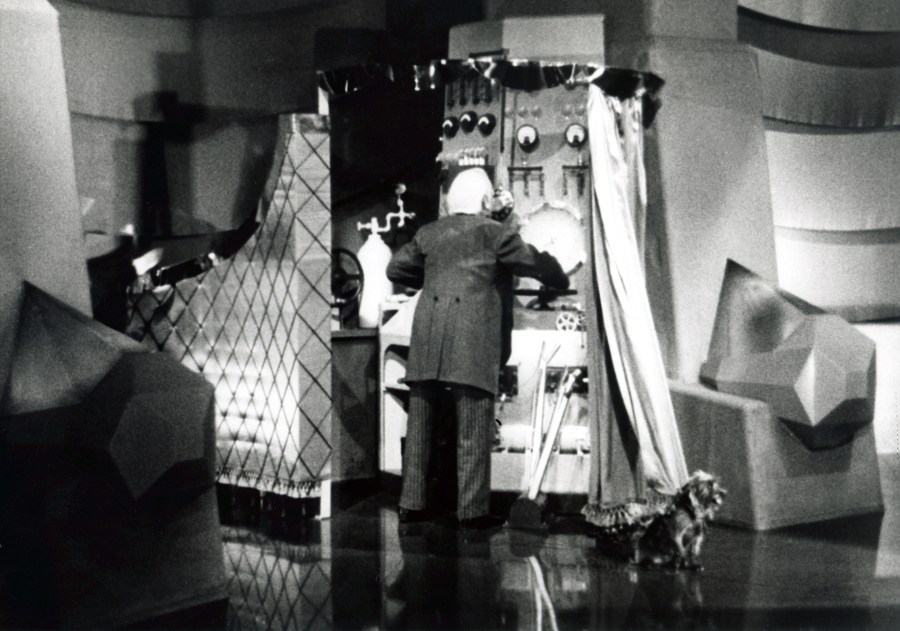
"Pay no attention to that man behind the drapery" was voted #24, while "There'due south no identify like home" nabbed the 11th spot. Finally, the ofttimes misquoted "Toto, I take a feeling we're not in Kansas anymore" landed in the 62nd spot.
The Witch's Burn down Employed Some Technical Wizardry (& Juice)
Clearly, the technical wizardry — or witchcraft — in the movie is incredible. Like the "equus caballus of a different color" sequence, another iconic, special furnishings-heavy scene harnessed the ability of everyday household items to pull off fun tricks.
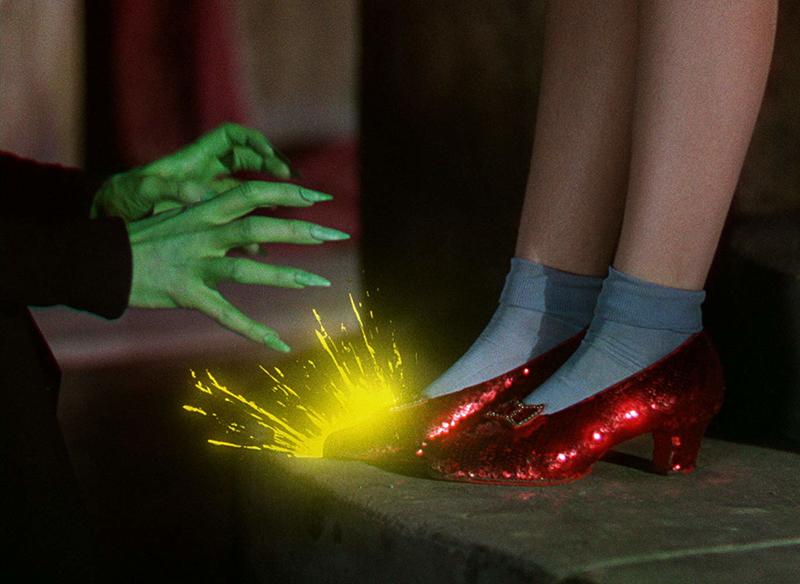
Soon afterwards Dorothy arrives in Munchkinland, the Wicked Witch tries to snatch the ruby slippers from the young girl'due south feet. Yet, fire strikes the Witch'south easily, repelling her. This "fire" is actually apple juice spouting from the slippers in a sped-up prune to make information technology look more flame-similar.
Technicolor Required Some Ingenuity in the Props Department
Experimenting with Technicolor was function fun and part trouble-solving for filmmakers. In order to properly capture scenes with the Technicolor photographic camera, the soundstage needed to be lit with arc lights, which often heated the gear up to a toasty 100 degrees.
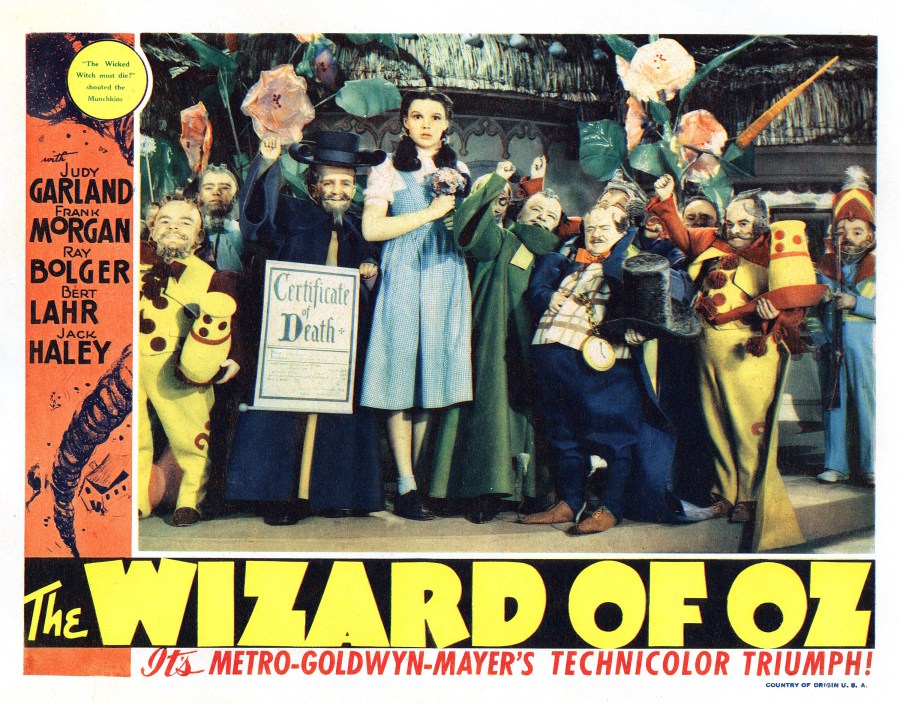
After the lights were ready, the experts experimented with what would look best on film, particularly in colorized class. For example, the white part of Dorothy'south dress is really pink — simply because it filmed ameliorate. And the oil the Tin Man is so excited about? It's really chocolate syrup.
The Wicked Witch of the East Makes More One Advent
Office of the Wicked Witch of the Westward's beef with Dorothy is that the young girl dropped a business firm on her sister, the Wicked Witch of the East, who was the short-lived owner of the ruby slippers. Although Margaret Hamilton already plays both the Wicked Witch of the West and her Kansas analogue Almira Gulch, she also plays the Wicked Witch of the East — if only briefly.
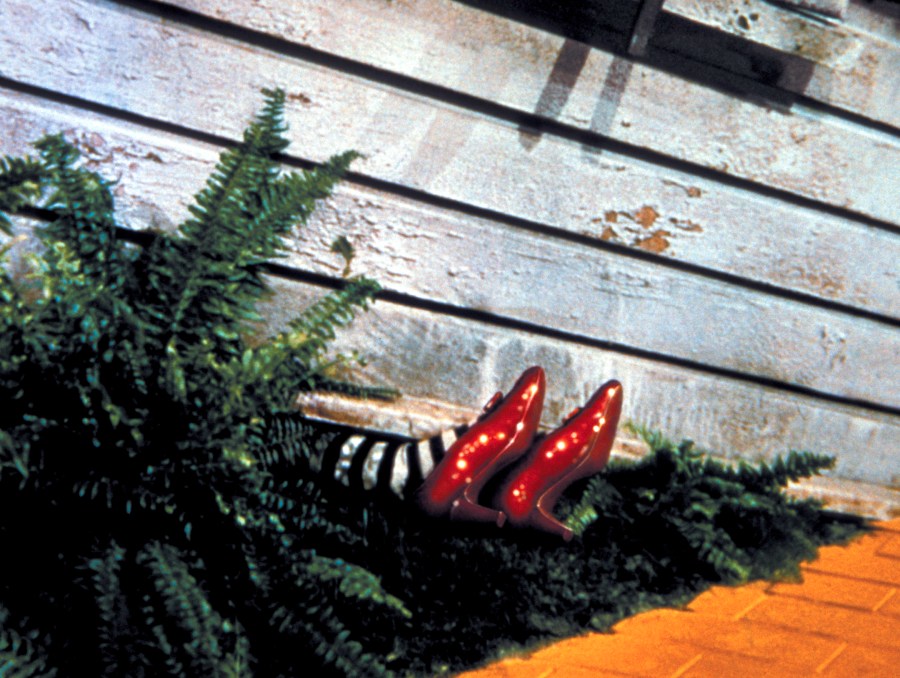
During the tornado sequence, an addled Dorothy looks out her bedroom window and watches Gulch transform into a witch, her shoes shimmering. For fans, this glint indicates the witch exterior the window is wearing the scarlet slippers. The restored version of the flick makes that shimmer even more noticeable.
The Film'southward Running Time Was Cutting Down Several Times
The first cutting of the motion-picture show clocked in at a running time of 120 minutes. Although that seems like zippo by today's Curiosity movie standards, producer Mervyn LeRoy felt information technology was long and unwieldy and wanted to chop off 20 minutes.
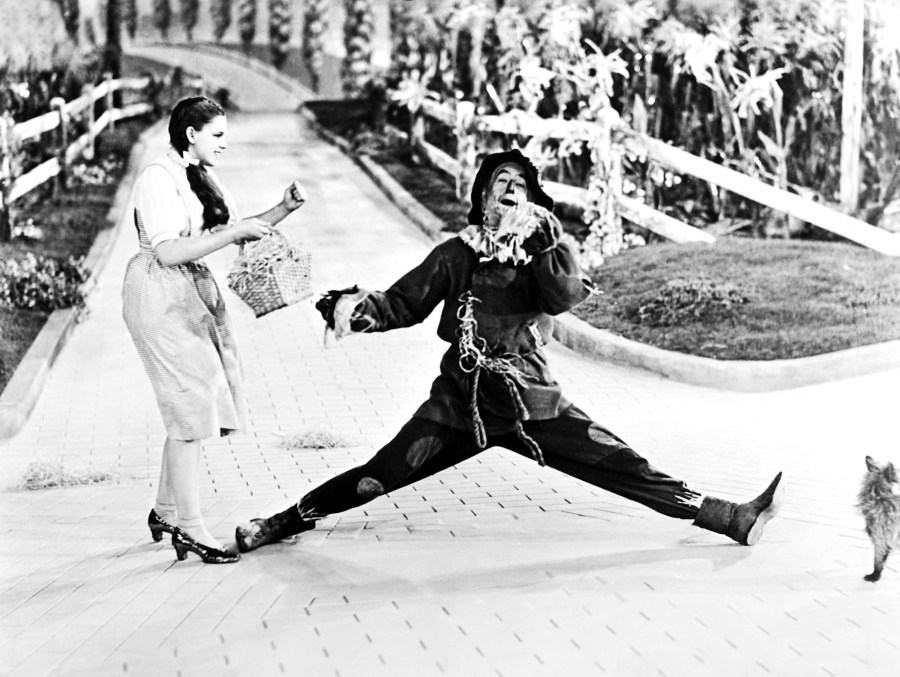
Subsequently cutting the famed "Jitterbug" number and an extended Scarecrow trip the light fantastic toe sequence, the motion picture was 112 minutes long. LeRoy held a 2nd preview screening, and, afterwards, nixed Dorothy's "Over the Rainbow" reprise, an Emerald Metropolis reprise of "Ding! Dong! The Witch Is Dead," a scene where the Can Man becomes a human beehive (Yikes!) and a few Kansas sequences.
And then Much for a "Wicked" Witch
Filmmakers deemed Margaret Hamilton's Wicked Witch of the West performance too frightening for audiences and cutting or trimmed many of her scenes. Only non everyone thought her performance was terrifying — namely Judy Garland, who played the Wicked Witch's nemesis, Dorothy Gale.
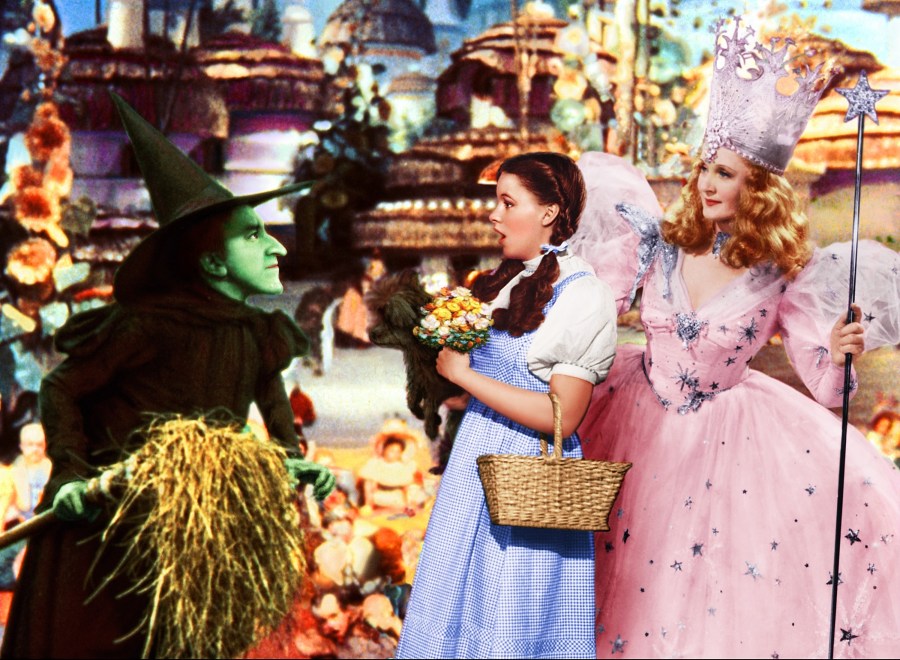
Off-screen, the film's starring foes were really friends. 1 story that emerged from the set described Garland excitedly showing off a wearing apparel to Hamilton, declaring she was going to wear it for her graduation. Unfortunately, MGM'due south Louis B. Mayer sent Garland on a printing tour the day of her graduation. Upset, Hamilton phoned Mayer and chewed him out.
Giving Credit to Technicolor
In the opening credits, the text reads "Photographed in Technicolor," every bit opposed to the more than apt "Color Sequences by Technicolor." The phrasing of the credits makes it seem as though the entire flick was shot in color. Was this washed deliberately, or was information technology a small syntactical faux pas?
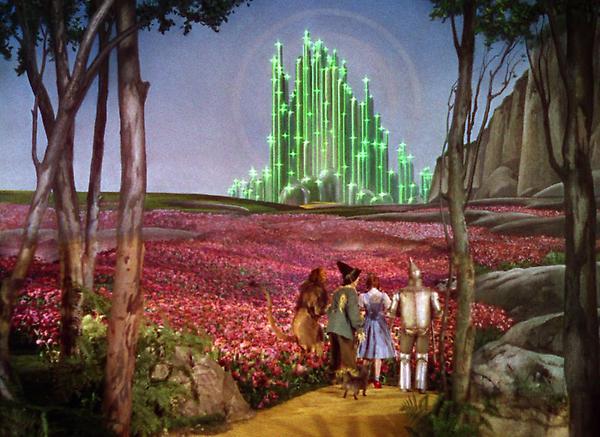
It's widely believed this was a bit of a stunt washed to enhance the surprise of the film turning into full 3-strip Technicolor when Dorothy arrives in Oz. Posters made at the fourth dimension of the film's debut made no mention of sepia tint (or "blackness-and-white"), adding credence to this theory.
One of History'due south Most-Watched Films
Although The Magician of Oz proved pop in theaters, another motion-picture show released the same twelvemonth, also directed by Victor Fleming, really topped the box part. (Yous may have heard of that petty picture — information technology'due south called Gone with the Wind.) Even so, MGM's musical fantasy may take more than staying power than other films of the era, thanks in part to re-releases.
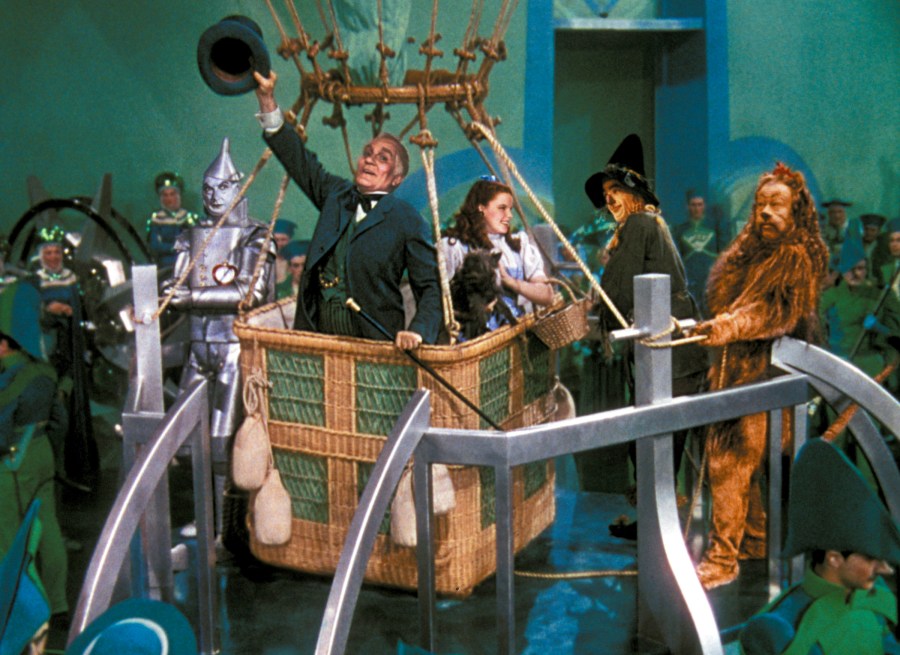
The film was get-go circulate on television on November 3, 1956, and garnered an impressive 44 million viewers. It'due south believed that The Wizard of Oz is one of the 10 most-watched feature-length movies in film history, largely due to the number of annual television screenings, theater viewings and various format re-releases.
70 Oz How Many Liters,
Source: https://www.ask.com/tv-movies/wizard-of-oz-facts?utm_content=params%3Ao%3D740004%26ad%3DdirN%26qo%3DserpIndex&ueid=a81ccdfa-99d3-404b-92fd-23c2f42ee06b
Posted by: zurcherpudge1936.blogspot.com


0 Response to "70 Oz How Many Liters"
Post a Comment